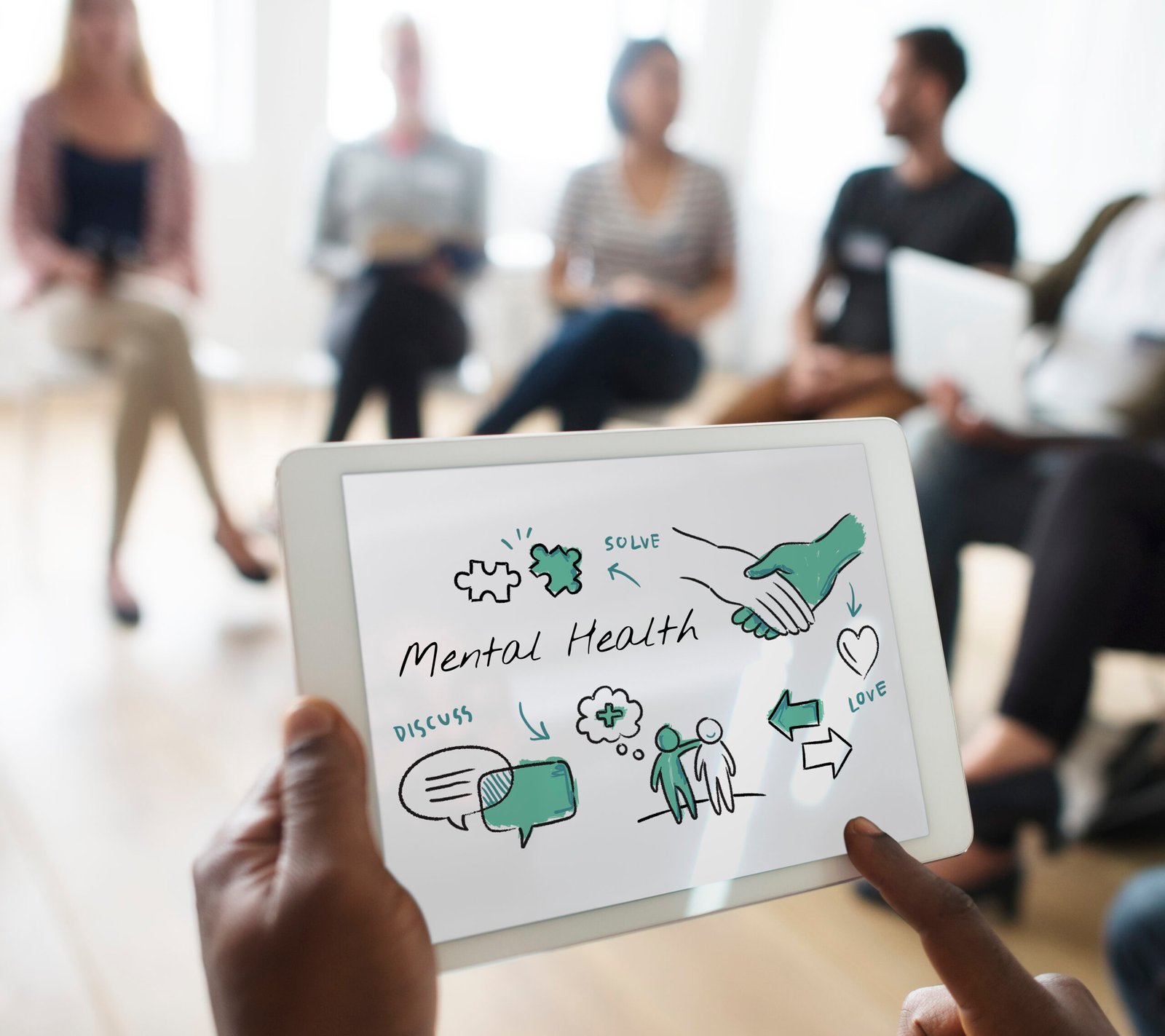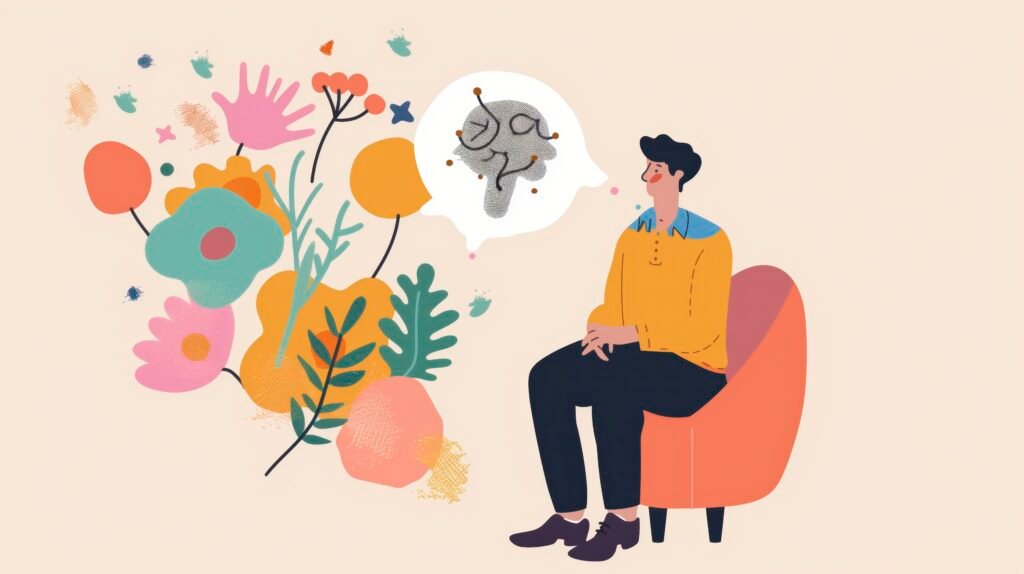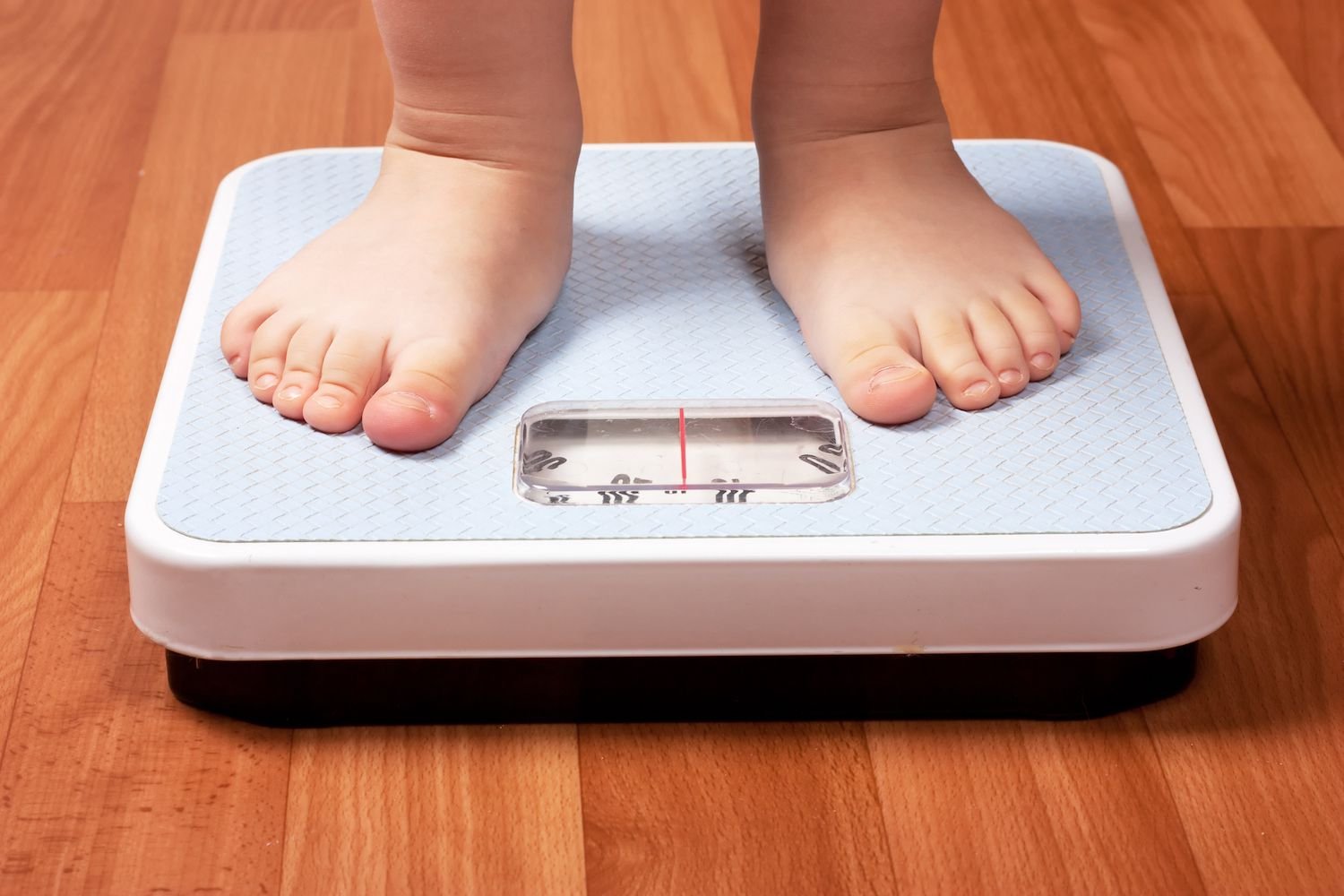Health & Wellness
Depression in Men : Decoding Physical, Mental, and Emotional Signs
Published
12 months agoon

Depression is a pervasive and serious condition that can affect individuals irrespective of their gender. While statistics from the Centers for Disease Control and Prevention (CDC) suggest that women may experience depression at higher rates, it’s crucial to recognize that men too grapple with this mental health disorder. The underrepresentation of men in depression statistics may be attributed to a complex interplay of social and biological factors, making it challenging to identify and diagnose depression in men. This article delves into the various facets of depression in men, exploring the physical, mental, emotional, and behavioral symptoms unique to this demographic.
Physical Symptoms of Depression in Men
While depression is commonly perceived as a mental health disorder, its impact often extends beyond the realms of the mind, leaving an indelible mark on the physical well-being of those affected. It is essential to delve into the distinctive physical symptoms of depression, shedding light on the intricate interplay between mental and bodily health.
1. Chest Tightness:
One of the physical manifestations of depression is the sensation of chest tightness. This seemingly unrelated symptom underscores the interconnectedness of mental and physical health. Individuals grappling with depression may experience this tightness, a physical expression of the emotional burden they carry. The acknowledgment of such symptoms is pivotal in understanding the holistic nature of depression in men.
2. Digestive Problems:
Depression in men can also manifest through digestive issues, including gas, diarrhea, and constipation. The gut-brain connection is a well-established aspect of mental health, and disruptions in digestive patterns may be indicative of underlying psychological distress. Recognizing these physical symptoms is crucial for an accurate diagnosis and the initiation of appropriate interventions.
3. Erectile Dysfunction and Sexual Problems:
Intimate aspects of a man’s life can be significantly affected by depression. Erectile dysfunction and other sexual problems may emerge as physical symptoms, impacting not only the individual’s personal life but also serving as markers of an underlying mental health struggle. It is imperative to address these issues in the broader context of depression in men, fostering a comprehensive approach to well-being.
4. Headaches:
Persistent headaches are another physical manifestation of depression. These headaches may vary in intensity and duration, often serving as a tangible expression of the emotional turmoil experienced by individuals facing depression. Recognizing the link between headaches and mental health is crucial for healthcare professionals and individuals alike, facilitating targeted interventions.
5. Hormonal Issues:
Depression in men can influence hormonal balance, leading to issues such as low testosterone levels. The intricate relationship between mental health and hormonal regulation underscores the complexity of depression’s impact on the body. Addressing hormonal imbalances is integral to a comprehensive treatment plan for men navigating the challenges of depression.
6. Pain:
Chronic pain, often diffuse and without apparent physical cause, can be a significant physical symptom of depression in men. The mind-body connection becomes evident as emotional distress translates into physical discomfort. Understanding and acknowledging pain as a symptom of depression is essential for tailored treatment strategies that address both the mental and physical aspects of the condition.
7. Racing Heart or Heart Palpitations:
Depression in men can manifest cardiovascular symptoms, including a racing heart or palpitations. These physical sensations may be distressing and contribute to an individual’s overall sense of unease. Recognizing these cardiac manifestations as potential indicators of underlying depression is crucial for comprehensive healthcare and effective treatment.
8. Unintended Weight Changes:
Fluctuations in weight, both gain and loss, can be physical manifestations of depression. Changes in appetite and eating patterns, influenced by emotional well-being, underscore the interconnectedness of mental and physical health. Monitoring weight changes can offer valuable insights into the progression of depression and guide personalized treatment plans.
Also Read: Reduce Biological Aging : 8 Heart-Healthy Habits That May Slow Aging by 6 Years
Mental Symptoms of Depression in Men
1. Inability to Concentrate:
Among the mental symptoms of depression in men, an inability to concentrate takes center stage. The mind, clouded by persistent feelings of despair and hopelessness, may struggle to focus on tasks and responsibilities. This cognitive impairment can significantly impact work, relationships, and overall daily functioning.
2. Memory Problems:
Depression can manifest as memory problems, affecting their ability to recall information and navigate day-to-day activities. The cognitive impact of depression extends beyond mere sadness, influencing fundamental processes of information processing and retention.
3. Obsessive-Compulsive Thought Patterns:
Men facing depression may experience obsessive-compulsive thought patterns, where intrusive and distressing thoughts dominate their mental landscape. These repetitive and often irrational thoughts contribute to heightened anxiety, exacerbating the overall impact of depression on mental well-being.
4. Racing Thoughts:
The tumultuous nature of depression in men can lead to racing thoughts, a relentless stream of ideas and worries that overwhelm the mind. This symptom can contribute to heightened stress levels, further intensifying the emotional toll of depression.
5. Sleep Issues:
Disruptions in sleep patterns, including difficulty falling asleep or staying asleep, are common mental symptoms of depression in men. Sleep serves as a barometer of mental health, and its disturbance can exacerbate feelings of fatigue and contribute to a sense of emotional fragility.
6. Suicidal Thoughts:
Perhaps the most alarming mental symptom, suicidal thoughts underscore the gravity of depression in men. The overwhelming sense of despair and hopelessness may lead some individuals to contemplate ending their lives. Identifying and addressing these thoughts is a critical aspect of mental health intervention.
Also Read: New Study Exposes a Link Between Marijuana and Heart Failure Risk
Emotional Symptoms of Depression in Men
1. Agitation:
Depression in men often manifests as heightened agitation, characterized by restlessness and irritability. Emotional turbulence may lead to a sense of inner turmoil, impacting both personal and professional relationships.
2. Aggression:
Men grappling with depression may exhibit aggressive behavior, a manifestation of the internal struggles they face. This emotional response can strain relationships and contribute to a cycle of isolation and distress.
3. Anger:
Unresolved feelings of anger are common emotional symptoms of depression in men. The societal expectation for men to be stoic may lead to the internalization of anger, further intensifying the emotional burden.
4. Emotional Withdrawal:
Depression in men may prompt emotional withdrawal from friends, family, and colleagues. The reluctance to share emotional struggles can contribute to social isolation, exacerbating the emotional toll of depression.
5. Hopelessness:
A pervasive sense of hopelessness is a hallmark emotional symptom of depression in men. The belief that things will not improve, coupled with a lack of motivation, can contribute to a deepening sense of despair.
6. Lack of Interest:
Depression may lead to a pervasive lack of interest in family, community, hobbies, and work. This emotional detachment further isolates men from sources of potential support and fulfillment.
7. Lack of Libido:
Intimate relationships may suffer as depression in men often correlates with a diminished libido. The emotional and physical toll of depression can impact one’s capacity for emotional and physical intimacy.
8. Restlessness:
Restlessness, both physically and emotionally, is a common emotional symptom of depression in men. The inability to find solace contributes to a sense of perpetual unease.
Also Read: Elevate Your Day with The Benefits of Morning Meditation
Behavioral Signs of Depression in Men
1. Difficulty Meeting Responsibilities:
Depression may manifest as a challenge in meeting work, family, and other personal responsibilities. The overwhelming weight of emotional distress can make it difficult for individuals to concentrate and fulfill their obligations, impacting both professional and personal spheres.
2. Drug Misuse:
In an attempt to cope with the emotional pain, some men may resort to drug misuse as a maladaptive coping mechanism. The self-medication approach is often an attempt to numb the emotional turmoil associated with depression in men.
3. Excessive Alcohol Consumption:
Depression may contribute to a tendency for excessive alcohol consumption. Alcohol may be sought as a means of temporarily escaping the emotional distress, leading to a cycle of dependency that further exacerbates the impact of depression on behavior.
4. Engaging in Risky Activities:
A notable behavioral sign of depression is the engagement in risky activities. This may include reckless driving, substance abuse, or engaging in unprotected sex. These behaviors often reflect a sense of emotional numbness or a subconscious desire to escape from the internal struggles associated with depression.
5. Social Isolation:
Men facing depression may withdraw from social interactions, contributing to a sense of isolation. The societal expectation for men to project strength and resilience may lead them to internalize their struggles, further intensifying the isolation experienced during bouts of depression.
6. Suicide Attempts:
In severe cases, depression may lead to suicidal thoughts and, tragically, attempts. The overwhelming emotional pain, coupled with a perceived lack of support or understanding, may drive some individuals to contemplate ending their lives.
Why Can Depression Go Undiagnosed in Men?
Understanding the behavioral signs of depression is crucial for dispelling the stigma that often shrouds discussions about mental health. Men, socialized by societal norms to internalize emotions and project strength, may resist seeking help even when exhibiting clear behavioral signs of depression. This resistance may stem from a fear of judgment, perpetuating a cycle of silent suffering.
The underdiagnosis of depression is further compounded by a lack of awareness regarding the less typical signs of the condition that men are more likely to experience. The societal pressure to conform to traditional views of masculinity discourages open conversations about mental health, leading many men to mask their struggles with excessive work hours or other activities rather than confronting the root of their depression.
Also Read: Unveiling the Marvels of Tea and Health Benefits in Lowering Blood Pressure
Breaking the Silence: Seeking Help for Depression
Acknowledging the behavioral signs of depression in men is a crucial step toward breaking the silence surrounding men’s mental health. By fostering open conversations, dismantling societal expectations, and encouraging men to seek help without judgment, we can create a more supportive environment for those navigating the complex terrain of depression.
Conclusion
In unraveling the intricate layers of depression, we discover the profound impact on physical, mental, emotional, and behavioral well-being. The unique symptoms provide glimpses into the nuanced challenges men face, often masked by societal expectations. Breaking the silence surrounding men’s mental health is imperative, fostering open conversations and dismantling stigmas. Through understanding and empathy, we can create an environment where men feel empowered to seek help without judgment, paving the way for early intervention and healing. In embracing a more compassionate approach, we contribute to a supportive landscape that acknowledges and addresses the complexities of depression in men.
Sahil Sachdeva is an International award-winning serial entrepreneur and founder of Level Up PR. With an unmatched reputation in the PR industry, Sahil builds elite personal brands by securing placements in top-tier press, podcasts, and TV to increase brand exposure, revenue growth, and talent retention. His charismatic and results-driven approach has made him a go-to expert for businesses looking to take their branding to the next level.

You may like

The technology landscape is evolving rapidly, and 2025 promises to be a year where groundbreaking innovations reshape industries, enhance daily life, and address global challenges. From the rise of generative AI to the continued expansion of 5G, here are the top 10 emerging technology trends you can’t afford to ignore in 2025.
1. Generative AI: Revolutionizing Creativity and Productivity
Generative AI is one of the most transformative trends in technology today. By 2025, generative AI will continue to disrupt industries like content creation, marketing, and design, allowing businesses to automate complex tasks and enhance personalization at scale. The ability of AI to generate human-like content, such as text, images, and audio, will fuel new opportunities for creativity, efficiency, and innovation, especially for businesses looking to stay ahead of the competition.
2. Quantum Computing: Unlocking Unimaginable Possibilities
While still in its developmental stages, quantum computing holds the key to solving complex problems that classical computers cannot. By 2025, quantum computing will make significant strides in fields such as cryptography, drug discovery, and AI, offering unprecedented computational power. The technology promises to revolutionize industries by enabling faster data processing and solving intractable problems in a fraction of the time it would take today.
3. 5G Expansion: Transforming Connectivity and IoT
The expansion of 5G technology will continue at an accelerated pace, significantly improving internet speeds and reducing latency. By 2025, 5G will be the backbone of next-generation technologies like IoT (Internet of Things), autonomous vehicles, and augmented reality. With faster, more reliable connections, businesses and consumers will experience seamless, real-time communication, further fueling innovation and growth in a wide range of industries.
4. Augmented Reality (AR) and Virtual Reality (VR): The Future of Interaction
AR and VR technologies are becoming increasingly mainstream, offering immersive experiences that transform everything from gaming to healthcare. In 2025, the application of AR and VR will expand beyond entertainment into areas such as education, real estate, and remote work. With advancements in hardware and software, these immersive technologies will blur the line between the physical and digital worlds, creating exciting new opportunities for businesses and consumers alike.
5. Edge Computing: Enhancing Speed and Efficiency
Edge computing is the next evolution of cloud computing. By processing data closer to its source, edge computing reduces latency and accelerates real-time decision-making, making it ideal for industries reliant on immediate data analysis, such as healthcare, autonomous vehicles, and smart cities. By 2025, edge computing will become critical for organizations looking to stay competitive in a data-driven world.
6. Blockchain Beyond Crypto: Transforming Industries
While blockchain technology is most commonly associated with cryptocurrencies, its potential stretches far beyond digital coins. By 2025, blockchain will become a mainstream technology in industries like supply chain management, healthcare, and voting systems, thanks to its ability to ensure secure, transparent, and immutable transactions. This technology promises to enhance trust, reduce fraud, and streamline business processes across various sectors.
7. Autonomous Vehicles: Changing the Future of Transportation
Self-driving cars are one step closer to becoming a common sight on roads, and by 2025, autonomous vehicles will be integral to the transportation ecosystem. From ride-sharing to freight delivery, autonomous vehicles will reduce traffic congestion, lower emissions, and improve safety. As AI and sensor technologies continue to improve, autonomous vehicles will transform not just how we travel, but how we think about transportation.
8. AI-Driven Cybersecurity: Protecting the Digital World
As cyberattacks grow in sophistication, AI-driven cybersecurity solutions are becoming more essential. In 2025, AI will play a pivotal role in defending against complex threats by enabling systems to detect anomalies, predict attacks, and respond in real time. By leveraging machine learning algorithms, businesses will be able to proactively secure their networks, protecting sensitive data and ensuring the safety of users and customers.
9. Wearable Technology: Advancements in Health Monitoring
Wearable technology is rapidly evolving, with devices that not only track physical activity but also monitor key health metrics like heart rate, blood sugar, and sleep patterns. By 2025, wearable devices will become even more advanced, using AI to provide personalized health insights and early detection of potential health issues. This technology will play a significant role in preventive healthcare, enabling individuals to take charge of their well-being like never before.
10. Sustainable Technologies: Paving the Way for a Green Future
As the world grapples with climate change, sustainable technologies are becoming critical in reducing carbon emissions and conserving natural resources. By 2025, innovations in renewable energy, energy-efficient devices, and sustainable manufacturing practices will drive industries toward a greener future. Solar power, wind energy, and electric vehicles will play a major role in reducing the environmental impact, contributing to a more sustainable world.

The year 2025 is shaping up to be a pivotal moment in the world of technology. From generative AI transforming creativity and business productivity to advancements in blockchain, autonomous vehicles, and AI-driven cybersecurity, the future promises to be dynamic and disruptive. As these technologies continue to evolve, businesses must stay ahead of the curve to remain competitive in an increasingly digital and interconnected world.
Business
The Rise of Wellness: A Trillion-Dollar Industry Transforms Health and Work Cultures
Published
2 weeks agoon
November 6, 2024
In today’s world, the global wellness industry has reached an astonishing milestone, with a market valuation of $6.32 trillion in 2023. This expanding industry now outpaces pharmaceuticals and sports, highlighting a significant shift in consumer priorities toward holistic health. The wellness market growth covers various sectors, including personal care, beauty, weight loss, nutrition, and even wellness real estate, showcasing an increased focus on mental and physical well-being in daily life.
The Wellness Boom: A Post-Pandemic Priority
Following the pandemic, individuals have become more health-conscious, leading to a surge in demand across wellness sectors, especially in personal care and nutrition. This post-pandemic wellness trend underscores the heightened importance people place on preventive health and self-care, resulting in a robust rebound for the wellness industry after the temporary setbacks experienced during COVID-19. North America, known for its higher expenditure in wellness, remains at the forefront of wellness market spending, emphasizing regional differences in health-related investments.
Corporate Wellness: Investing in Employee Well-Being
The corporate wellness market is also expected to witness considerable expansion by 2032 as companies increasingly recognize the value of prioritizing employee health. Employers are investing in wellness initiatives—like mental health resources, fitness programs, and wellness retreats—to foster a happier, healthier workforce. This evolution in workplace culture signals a new era where corporate wellness programs are as essential as traditional benefits, underscoring the strong connection between well-being and productivity.
Hybrid Work and Remote Job Satisfaction
The rise of hybrid work productivity is another trend reshaping the wellness industry. Research shows that employees working in a hybrid model report similar productivity levels to in-office employees while experiencing higher job satisfaction. Many credit this satisfaction to the flexible balance between work and personal life that hybrid work enables. Reflecting the quirks of remote work, Kevin O’Leary recently commented on the “business on top, casual on the bottom” fashion trend during a television appearance, capturing the essence of remote work culture.
Tech Innovations: Smart Glasses and Health Monitoring
In the tech world, wellness trends are influencing the development of new devices. Following Meta’s success with its recent launches, Apple is now considering entering the smart glasses market. With wearable technology already playing a pivotal role in health tracking, Apple’s potential entry could further revolutionize how people engage with their well-being.
Surprising Shifts in Wealth and Health Culture
A recent analysis also uncovered that the wealthiest U.S. city is not in New York or California, reflecting new demographic trends in wealth and wellness priorities across regions. This unexpected shift further emphasizes how health and wellness are spreading beyond traditional high-income areas, with other regions leading in wellness-oriented lifestyles and investments.

Wellness Industry Trends: The Future Outlook
The future of the wellness industry points to sustained growth across various areas, from corporate wellness to advanced personal care solutions. Companies are likely to increase their investment in wellness programs, creating a more supportive workplace culture focused on employee well-being. As health and wellness industry trends continue to evolve, the industry’s growth will likely see further expansion into wellness tourism, sustainable health products, and more personalized wellness solutions.
This remarkable rise of the global wellness industry exemplifies the shift in modern values, with a focus on health, fulfillment, and a balanced lifestyle. The wellness sector’s continued growth signals a bright future where personal well-being takes center stage in both our personal and professional lives.
Health
Prioritizing Mental Health: The Core of Successful Businesses
Published
2 weeks agoon
November 5, 2024
In the contemporary business landscape, prioritizing mental health has emerged as a fundamental aspect of effective leadership. While many companies traditionally focus on financial performance and operational efficiency, the mental well-being of both leaders and employees is now recognized as essential for fostering a thriving workplace. By understanding the profound impact that mental health has on productivity, creativity, and overall organizational success, businesses can create environments that empower individuals to perform at their best.
The Importance of Mental Health in Businesses
Mental health is often overlooked in the corporate world, yet it plays a significant role in the overall performance of businesses. Companies that prioritize mental well-being see higher employee engagement, reduced absenteeism, and a more positive workplace culture. When leaders focus on their mental health and encourage their teams to do the same, they create an environment where everyone can thrive.
Signs That It’s Time to Prioritize Mental Health
Businesses must recognize the signs that indicate it’s time to prioritize mental health initiatives. Common symptoms include increased stress, poor communication, and a decline in productivity. If team members exhibit changes in behavior or mood, it’s a signal that mental health support is needed.
Strategies for Businesses to Prioritize Mental Health
- Create a Supportive Culture: Foster an environment where employees feel safe discussing mental health issues without fear of stigma. Encourage open dialogue and provide resources for support.
- Implement Mental Health Programs: Offer workshops, counseling services, and wellness programs that focus on building mental resilience and coping strategies.
- Promote Work-Life Balance: Encourage employees to take breaks, use their vacation time, and maintain a healthy work-life balance. This can significantly reduce stress and burnout.
- Lead by Example: Business leaders should openly prioritize their mental health, demonstrating its importance to their teams. Sharing personal experiences can help normalize conversations around mental well-being.
The Business Case for Prioritizing Mental Health
Investing in mental health is not just a moral obligation; it’s a smart business strategy. Companies that prioritize mental well-being enjoy lower turnover rates and increased productivity, leading to higher profitability. When businesses recognize that mental health is a core component of success, they position themselves to attract and retain top talent.

As we move forward in an increasingly competitive marketplace, the need for businesses to prioritize mental health has never been more critical. By taking proactive steps to address mental well-being, companies can create a healthier work environment, leading to sustainable success. Let 2025 be the year that mental health becomes a central focus for businesses everywhere.
Health
Health experts discovered GLP-1 Drugs Could Prevent 34,000 Heart Attacks and Strokes Annually in the U.S.,
Published
2 months agoon
September 19, 2024
Health experts have discovered that certain blockbuster weight-loss drugs could significantly reduce the risk of heart attacks, offering new hope for broader cardiovascular protection. Certain blockbuster weight-loss drugs have been found to offer significant protection to the heart, and new research indicates that the cardiovascular benefits of these drugs may extend to a much broader set of patients than clinical trial data has previously shown. This new insight suggests that these drugs, specifically GLP-1 receptor agonists, could prevent tens of thousands of heart attacks and strokes in the United States each year. These findings could mark a substantial shift in how these drugs are viewed, moving beyond their use for weight loss to potentially becoming critical tools in preventing cardiovascular events on a much larger scale.Clinical trial data from Novo Nordisk, the pharmaceutical company behind Wegovy, showed that people who used the drug had a 20% lower risk of experiencing a cardiac event, such as a heart attack or stroke, compared to those who were given a placebo. This data prompted the U.S. Food and Drug Administration (FDA) in March to approve an update to Wegovy’s label, making it the first weight-loss medication officially approved to reduce the risk of heart attack, stroke, or heart-related death in individuals who are at a higher risk of these conditions. Wegovy belongs to a class of drugs known as GLP-1 receptor agonists, and its active ingredient, semaglutide, is also available as Ozempic for the treatment of type 2 diabetes. Novo Nordisk’s clinical trial, however, was limited to people who were living with obesity and had already experienced a previous cardiovascular event, such as a heart attack or stroke, or those with symptoms of peripheral artery disease, which includes conditions like clogged arteries in the limbs. This group is at higher risk of future heart problems, and the trial focused on whether Wegovy could help prevent subsequent events in this population.
Now, new research from Dandelion Health, a health platform leveraging real-world data and artificial intelligence (AI) to advance personalized care, suggests that GLP-1 drugs could also be highly effective as a primary prevention method. This means that these drugs might significantly reduce the risk of heart attacks and strokes even for people who have mild or moderate cardiovascular disease but have not yet suffered a major cardiovascular event. The implications of this research are profound, as it suggests that GLP-1 receptor agonists could benefit an even larger group of people than previously thought, extending beyond those with a history of heart disease.
The researchers at Dandelion Health used AI to analyze real-world medical records of patients who shared similarities with those in the Novo Nordisk clinical trial but had no history of major cardiovascular events. By tracking years of medical data, particularly focusing on electrocardiogram readings (which measure the heart’s electrical activity), the AI model predicted the potential benefits of GLP-1 drugs in reducing the risk of heart attacks and strokes. The AI-driven predictions were then validated against actual patient outcomes.
What the researchers found was striking: GLP-1 receptor agonists reduced the risk of heart attack or stroke by 15% to 20%—a result that mirrors the findings of the clinical trial but for a much broader population. Based on these results, the researchers estimate that if everyone in this larger group of potentially eligible patients took GLP-1 drugs, it could prevent around 34,000 heart attacks and strokes in the U.S. each year. This could transform the way cardiovascular disease is managed in millions of people, marking a shift toward using GLP-1 drugs as a cornerstone in heart disease prevention.
“In clinical research, you take the moderate to severe patients because you require fewer patients to prove out the efficacy. But there’s this huge danger that you will consistently miss the impact of medication on broader populations because you just can’t afford the time or money to study them. This is just a natural flaw of clinical research,” explained Elliott Green, co-founder and CEO of Dandelion Health. He emphasised that broadening the scope of research through the use of AI can help capture data on patients who might otherwise be overlooked in traditional clinical trials—those he referred to as the “clinically silent” group.
The potential for GLP-1 drugs to reshape cardiovascular care has already been transformative. Many experts now consider these drugs not merely as weight-loss solutions but as powerful tools that promote overall health, particularly heart health. Dr. Harlan Krumholz, a cardiologist and scientist at Yale University and Yale New Haven Hospital, who was not involved in the Dandelion Health analysis, sees the growing evidence of the cardiovascular benefits of GLP-1s as potentially game-changing. “We could reframe the discussion,” Krumholz said, explaining that instead of focusing solely on the weight-loss effects of these drugs, the conversation could shift to how they help reduce cardiovascular risk and promote longer, healthier lives. This added evidence of heart health benefits may help persuade more people to consider the use of GLP-1 drugs.
Dr. Brendan Everett, a cardiologist at Brigham and Women’s Hospital and associate professor at Harvard Medical School, is among the physicians who have already begun prescribing GLP-1 drugs for their cardiovascular benefits. “I am a preventive cardiologist who wants people to be well and has watched this epidemic of obesity and what we call cardiometabolic disease consume the United States over the past two or three decades,” he said. Everett highlighted that GLP-1 drugs have created an “absolute paradigm shift” in the way cardiovascular disease is treated. He believes that expanding the use of these drugs to patients with mild or moderate cardiovascular disease could provide even greater benefits, as long as the costs and prevention goals are clearly understood.
However, the cost of GLP-1 drugs remains a critical consideration. A recent analysis published in *Health Affairs* suggested that if Medicare were to cover weight-loss drugs like Wegovy, Part D spending could increase by $3 billion annually, even if only 5% of eligible patients were prescribed the drug. However, preventing costly heart attacks and strokes through the use of GLP-1 drugs could potentially offset these costs in other areas of healthcare. For example, research from last year found that each heart attack costs hospitals an average of about $19,000.
While clinical trials with randomized controls, such as those conducted by Novo Nordisk, remain the gold standard for determining the safety and efficacy of medications, AI-driven research like that from Dandelion Health offers valuable insights. This new research also had some advantages over the Novo Nordisk trial. For instance, the Dandelion Health analysis included a more diverse patient population, with a more balanced ratio of men and women and nearly three times the number of non-white patients. Additionally, the AI model was able to identify the decreased cardiovascular risk in less than two years, whereas the Novo Nordisk clinical trial took over three years to complete.
As heart disease remains the leading cause of death in the United States and stroke is the fifth leading cause, the opportunities to improve cardiovascular health through the use of GLP-1 drugs are significant. With the growing popularity of these medications, additional data from real-world analyses and clinical trials could help healthcare providers better allocate the currently limited supply to those who would benefit the most.
Health & Wellness
Weight loss drug liraglutide shows promise for younger children with obesity, study finds
Published
2 months agoon
September 12, 2024
In a recent study, children who used the weight loss drug liraglutide experienced a significant reduction in weight compared to those who received a placebo. This groundbreaking research sheds light on a potential new treatment avenue for younger children struggling with obesity, a group that has traditionally relied on non-pharmaceutical interventions such as diet and exercise.
Managing obesity is challenging for individuals of all ages, but it is particularly difficult for children. While adults and adolescents aged 12 and older have access to GLP-1 receptor agonists, a class of medications effective for weight management, younger children typically rely solely on lifestyle modifications. These include dietary changes, increased physical activity, and behavioral counseling. Despite these efforts, substantial weight loss in younger children has often proven elusive, with most interventions yielding only modest results.
Liraglutide, known commercially as Saxenda and Victoza, was initially approved by the US Food and Drug Administration (FDA) in 2014 for weight loss in adults. Its approval was expanded in 2020 to include children aged 12 to 17. The recent study, published in the New England Journal of Medicine and presented at the annual European Association for the Study of Diabetes conference, represents the first investigation into liraglutide’s effects on children aged 6 to 12 with high BMI.
Conducted by Dr. Claudia Fox, a pediatrician at the Center for Pediatric Obesity Medicine at the University of Minnesota Medical School in Minneapolis, the study involved 82 children. These participants were divided into two groups: 56 children received daily liraglutide injections, while 26 received a placebo. All participants also received counseling designed to promote healthier eating habits and an increase in physical activity, specifically moderate to high-intensity exercise for at least an hour each day.
The results were notable. After just over a year, children in the liraglutide group experienced a 5.8% reduction in BMI, compared to a 1.6% increase in the placebo group. This represents a 7.4 percentage point difference in BMI between the two groups. These findings align with previous studies involving teenagers but were even more pronounced in the younger children studied.
Liraglutide was generally well-tolerated by the participants, though some adverse effects were reported. Both the liraglutide and placebo groups experienced gastrointestinal issues, such as nausea, diarrhea, and vomiting, with these symptoms being more prevalent among those receiving the medication. However, these side effects were mostly transient and did not result in a high dropout rate.
The study has several important implications but also some limitations. One key unanswered question is the long-term effectiveness and safety of liraglutide for younger children. The trial did not explore how long children would need to remain on the medication or the long-term effects of discontinuing it. After the study period ended and medication and counseling stopped, BMI levels among participants began to increase again, although the rise was less pronounced compared to previous studies involving teenagers. This suggests that early intervention with liraglutide might offer more durable results, but additional research is needed to confirm this.
Obesity is a prevalent and serious health issue among children in the United States, affecting nearly 20% of the population. This condition often persists into adulthood, leading to various health problems such as type 2 diabetes, cardiovascular disease, and other serious conditions. Effective treatments for childhood obesity are crucial not only for managing weight but also for preventing long-term health complications.
Developing and implementing weight loss medications for children is complex due to their ongoing growth and development. It is crucial to ensure that such treatments do not negatively impact physical growth or developmental milestones. Although the study did not indicate any adverse effects on growth or puberty, further research is essential to verify that liraglutide does not interfere with these important developmental processes.
The potential benefits of weight loss medications like liraglutide must be weighed against their costs and long-term effects. While the current research is promising, more studies are needed to fully understand the implications of such treatments for young children. These studies should focus on long-term safety, potential impacts on growth and development, and the overall efficacy of maintaining weight loss over time.
In summary, the study on liraglutide offers a promising new option for managing obesity in younger children. With significant weight loss observed and a generally acceptable safety profile, liraglutide could become a valuable tool in treating childhood obesity. However, further research is needed to fully understand its long-term impact and to ensure its safe and effective use in the younger population.
Health
How a Weekend Nap Might Boost Your Heart Health, New Research Reveals
Published
3 months agoon
September 6, 2024
When a demanding week disrupts your regular sleep routine, catching up on sleep over the weekend often seems like a sensible remedy. However, new research suggests that this approach might offer more than just temporary relief—it could actually benefit your heart health. Set to be presented at the European Society of Cardiology’s annual congress on September 1, the study indicates that making up for lost sleep on weekends is linked to a significantly lower risk of developing heart disease.
This research, based on data from the UK Biobank study involving over 90,000 participants, reveals intriguing findings. Those who used weekends to compensate for lost sleep showed a 19% lower risk of heart disease compared to individuals who didn’t catch up as much. The benefit was notably greater for those who regularly faced inadequate sleep during the workweek. Over an average follow-up period of nearly 14 years, participants who averaged the most additional sleep on weekends were less likely to develop serious cardiovascular conditions, such as heart disease, heart failure, atrial fibrillation, and stroke.
For people suffering from chronic sleep deprivation—defined as getting less than seven hours of sleep per night—this research found that catching up on sleep over the weekend reduced the risk of heart disease by 20%. This suggests that even intermittent sleep recovery can have a protective effect on cardiovascular health.
Despite these promising results, experts stress the importance of maintaining a consistent sleep schedule throughout the entire week. Irregular sleep patterns, often referred to as “social jet lag,” can have detrimental effects on heart health, undermining the benefits of weekend sleep recovery. For instance, excessive weekend sleep might not fully mitigate the adverse effects of insufficient sleep during the week.
The research, while compelling, remains in abstract form and has some limitations. It primarily reflects the UK population, and the study’s methodology does not yet account for all potential risk factors for heart disease or variations in individual sleep needs. Further research is needed to determine the optimal amount of daily sleep and whether there are thresholds beyond which additional weekend sleep offers no further benefit.
Dr. Nieca Goldberg, medical director of Atria New York City and a clinical associate professor of medicine at New York University’s Grossman School of Medicine, emphasizes the broader implications of the findings. She points out that chronic sleep deprivation is known to contribute to various cardiovascular issues, including high blood pressure, high cholesterol, obesity, diabetes, and stroke. Therefore, while catching up on sleep can be beneficial, it is crucial to aim for a consistent sleep routine to maximize heart health.
Other experts, like Dr. Nour Makarem from Columbia University’s Mailman School of Public Health, highlight that maintaining regular sleep patterns every day is likely the best strategy for long-term health. They also suggest discussing sleep issues with healthcare providers to address any underlying problems and ensure the most effective approach to improving sleep and overall cardiovascular health.
In summary, while making up for lost sleep on weekends appears to offer heart health benefits, the ideal approach is to maintain a consistent and adequate sleep schedule throughout the week. Further research will be needed to refine these findings and provide more specific guidelines for optimizing sleep for heart health.
Health
Jason Momoa and Danielle Brooks Star as New Additions in ‘Minecraft’ Movie Trailer
Published
3 months agoon
September 5, 2024
The vibrant, cubic universe of Minecraft is set to leap off the screen with the release of the first teaser trailer for “A Minecraft Movie,” the highly anticipated live-action adaptation of the beloved video game. Starring Jason Momoa, Danielle Brooks, and Jack Black, the film promises to bring the pixelated world of Minecraft to life in an exciting new way.
The teaser introduces Momoa as Garrett “The Garbage Man” Garrison, who, along with Brooks, “Wednesday” star Emma Myers, and Sebastian, finds himself transported into the enchanting realm of Minecraft through a mysterious portal. The trailer showcases their journey through this imaginative landscape, where they encounter various Minecraft creatures like bleating sheep, menacing piglins, and an intriguing character named Steve, played by Jack Black.
In a memorable moment from the trailer, Black’s character declares, “Anything you can dream about here, you can make,” while The Beatles’ “The Magical Mystery Tour” plays in the background. This line underscores the movie’s theme of creativity and exploration in the fantastical world of Minecraft.
The film’s official synopsis reveals that Momoa’s character and his friends face ordinary challenges that become extraordinary once they are thrust into the Overworld, a surreal and cubic wonderland that thrives on imagination. To return home, they must embrace their unique creative abilities, which will ultimately help them in their real-world lives.
Directed by Jared Hess, known for “Napoleon Dynamite” and “Masterminds,” “A Minecraft Movie” marks the first live-action adaptation of the popular video game that originally launched in 2011. The film is a collaborative effort between Warner Bros. Pictures and Legendary Pictures, and is scheduled to hit theaters on April 4, 2025.
Health
Raygun Apologizes to Breakdance Community for Controversial Paris Olympics Performance
Published
3 months agoon
September 5, 2024
Rachael Gunn, known in the breakdancing world as Raygun, has issued a heartfelt apology to the breaking community following the significant backlash from her performance at the 2024 Paris Olympics. The 37-year-old university lecturer and breakdancer garnered international attention for her unique and unconventional routine, but her performance did not resonate with many in the sport, leading to a storm of criticism.
In an interview aired on the Australian current affairs show “The Project,” Gunn expressed her deep regret over the negative impact her Olympic appearance had on the breaking community. Gunn’s performance, which featured distinctive moves like the kangaroo hop, backward rolls, and various contortions while lying or crawling on the floor, did not score a single point in her matches against competitors from the United States, France, and Lithuania. She lost each round 18-0, a result that fueled the controversy surrounding her style and approach.
Gunn’s style was met with confusion and disapproval from many in the breaking community, who felt that her routine diverged significantly from traditional breakdancing elements. Despite qualifying for the Olympics by winning the Oceania championships, Gunn admitted in her interview that she was nervous about competing and anticipated a mixed reception to her performance. “I knew that I was going to get beaten, and I knew that people were not going to understand my style and what I was going to do,” she said. “The odds were against me, that’s for sure.”
The reaction to Gunn’s performance extended beyond the breaking community and captured the attention of the global media. Singer Adele publicly questioned the seriousness of the performance during a concert in Munich, while actress Rachel Dratch parodied Gunn’s routine on “The Tonight Show Starring Jimmy Fallon.” Gunn revealed that she had not seen the Fallon sketch but felt conflicted about the attention it brought her. “I don’t know whether to hug (Fallon) or yell at him, because what platform he ended up giving me,” she remarked.
Gunn’s performance, while controversial, was a bold attempt to bring a new perspective to breakdancing, a sport that made its Olympic debut in Paris but will not be featured in the 2028 Los Angeles Games. Gunn’s approach, though not widely accepted, highlights the ongoing debate within the sport about the balance between innovation and tradition.
In light of the backlash, Gunn has decided to take a step back from competitive breakdancing. She expressed a desire to avoid the spotlight and focus on the positive aspects of her experience, including the joy and fun she found in performing. “I would much rather focus on the positives out of this, and the positive responses and the joy that I brought people,” she said. Gunn emphasized that her goal was to have fun and push boundaries, even in the face of defeat.
Rachael Gunn’s apology and decision to step away from competition reflect her acknowledgment of the controversy and her commitment to the sport, despite the challenges she faced. Her story underscores the complexities of introducing innovative approaches to traditional sports and the need for ongoing dialogue within the breaking community about the future direction of the sport.
Health
Fatman Scoop, Renowned Rapper with Hits for Mariah Carey and Missy Elliott, Dies at 56 After Stage Collapse
Published
3 months agoon
September 2, 2024
Fatman Scoop, the acclaimed rapper and hype man known for his collaborations with Missy Elliott and Mariah Carey, has passed away at the age of 56 after collapsing onstage during a concert in Hamden, Connecticut. The news was confirmed by his publicist, Chanel Rae, who directed fans to a tribute posted on Fatman Scoop’s official Instagram page. The tribute described him as a “radiant soul” and “beacon of light,” recognizing him not only as a top performer but also as a father, brother, uncle, and friend. Hamden Mayor Lauren Garrett also offered condolences on Facebook, acknowledging the large turnout for what would be Fatman Scoop’s final performance and expressing gratitude to those who provided life-saving assistance. She announced that grief counseling would be available for those affected by the tragedy. Sharron Elkabas, the musician’s representative, expressed shock at his sudden death, noting that he had been in good spirits recently. Details regarding the cause of death have not yet been released. Fatman Scoop gained prominence with his 1999 hit “Be Faithful” and went on to collaborate with notable artists such as Lil Jon, Janet Jackson, Whitney Houston, Pitbull, and Skrillex. His contributions included helping to make Missy Elliott’s 2005 single “Lose Control” a hit and collaborating with Mariah Carey on “It’s Like That,” earning him a Grammy in 2006 for best short form music video
Health & Wellness
CDC Urges Check of Fridges Amid Expanding Listeria Outbreak Linked to Recalled Deli Meat
Published
3 months agoon
August 30, 2024
The US Centers for Disease Control and Prevention is warning the public to avoid consuming recalled deli meats amid a significant listeria outbreak, which has become the largest in the US since 2011.
In late July, Boar’s Head recalled over 7.2 million pounds of its ready-to-eat liverwurst and other deli meat products due to potential listeria contamination. Recently, the CDC has reported at least a dozen additional listeriosis cases linked to the outbreak.
Documents from the US Department of Agriculture reveal that insects and mold were found at the facility connected to the recall. The outbreak has resulted in 57 hospitalizations across 18 states and nine deaths. The CDC notes that this outbreak is now the largest since the 2011 listeria outbreak linked to cantaloupe.
The CDC also indicates that the actual number of illnesses might be higher, as some milder cases may not have been tested for listeria. There is also a delay between when an illness occurs and when it is linked to an ongoing investigation.
Consumers are advised to check their kitchens for any remaining recalled products, as they can have a long shelf life. Look for “EST. 12612” or “P-12612” inside the USDA mark of inspection on labels. Some products have sell-by dates extending into October 2024. Recalled items include liverwurst, ham, bologna, sausage, and roasted bacon. Most reported illnesses are associated with eating turkey or liverwurst, though some involve ham.
Boar’s Head has stated that products currently available at deli counters are not part of the recall.
Trending
-

 Health3 years ago
Health3 years agoEva Savagiou Finally Breaks Her Silence About Online Bullying On TikTok
-

 Health2 years ago
Health2 years agoTraumatone Returns With A New EP – Hereafter
-

 Health3 years ago
Health3 years agoTop 5 Influencers Accounts To Watch In 2022
-

 Fashion3 years ago
Fashion3 years agoThe Tattoo Heretic: Kirby van Beek’s Idea Of Shadow And Bone
-

 Fashion3 years ago
Fashion3 years agoNatalie Schramboeck – Influencing People Through A Cultural Touch
-

 Health3 years ago
Health3 years agoTop 12 Rising Artists To Watch In 2021
-

 Health3 years ago
Health3 years agoTop 10 Influencers To Follow This 2021
-

 Health3 years ago
Health3 years agoMadison Morton Is Swooning The World Through Her Soul-stirring Music
-

 Health3 years ago
Health3 years agoBrooke Casey Inspiring People Through Her Message With Music
-

 Health3 years ago
Health3 years agoFiery, Electric, And Tenacious. Leah Martin-Brown’s All That
